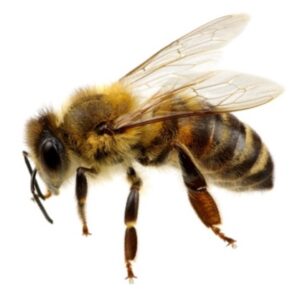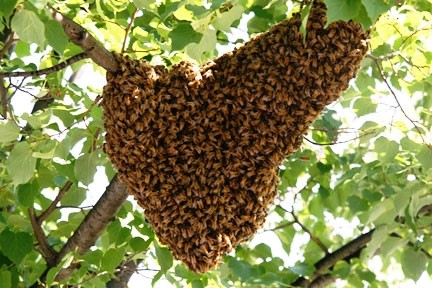Knowing the Difference Between Stinging Insects Can Help Avoid Unwanted Encounters
All animals and insects, big and small, play a role in creating unique ecosystems across the globe. However, not all stinging insect species have a role that benefits others in their environment.
Invasive pest species, like brown marmorated stink bugs, take advantage of local resources without consequences, as they usually don’t have predators outside their native regions. And some native insects can pose serious health and property risks.

Honeybees are considered not aggressive but can be confused with the more aggressive Africanized bees.
Aggressive stinging insects, such as wasps and hornets are often easily mistaken for “bees.” Knowing the difference between various stinging insects can help you, your employees and customers avoid getting stung and to understand when it’s necessary to have a nest or hive removed.
The Difference Between Bees and Wasps
Many stinging insects have similar coloring and patterns, but it is possible to tell different species apart by their body shape and the type of nests they build. If a client suspects that a colony of insects has built a nest in or near their facility or property, a general identification of honeybees versus yellowjackets can help pest professionals determine the next steps to take in pest removal.
Bees
Bumble bees usually nest in dark cavities or in the ground. They are a traditional “bee shape,” have light yellow and black coloring and are often described as fuzzy. Bumble bee nests are made of wax.
Honeybees are a yellow-orange color. During the spring, honeybee colonies may swarm. Swarming is the process of honeybee colony reproduction and involves the splitting of a colony where 30 to 50 percent of the bees leave the hive with the old queen. The swarm flies to a temporary site for a day or two before a new permanent nest site is chosen. These swarms often alarm people, but bees in this state are very docile because they don’t yet have a nest to defend. Honeybees prefer to build a nest in a sheltered location such as a hollow tree, wall, or attic and seek out such locations. Swarms are valuable to beekeepers and most local beekeeping clubs, or police keep list of beekeepers willing to collect swarms. Honeybees are considered not aggressive but can be confused with the more aggressive Africanized bees that’s why is necessary to proceed to taxonomic or genetic test before try to remove any type of bee nest.
Carpenter bees are almost twice the size of other bee species and are much rounder. They are mostly black with yellow and make their nests by boring holes into wood. Each female bee constructs her own nest, considered solitary bees.
Wasps
Wasps are mostly identifiable by their nests. They use materials such as mud, clay or a paper-like substance. These can be built in trees, shrubs, porch ceilings, rafters, eaves, or doors. Wasps can also be a combination of colors including black, blue, yellow and red, and they have more of an hourglass shape than bees. Some wasp species, like yellowjackets, hornets and paper wasps are social insects that live in colonies in the way that ants, bees and termites do; others, like mud daubers, are solitary and do not live in colonies.
Hornets can have varied coloring that make them easy to confuse with bees. The most common type is the European hornet. This stinging insect is mostly brown with yellow stripes on its abdomen. They are primarily a forest-dwelling insect but are drawn to lights and can alarm unsuspecting people who encounter them. Although called hornets, bald-faced hornets are a variety of yellowjacket. They are black and white and get their name from their white face.
Yellowjackets have stark yellow and black bands across their abdomen. They may nest in the ground around plant roots or logs, in structures, in bushes, or in trees, depending on the species. The nests are made of paper and can be the size of a basketball. They are more aggressive than paper wasp and hornets.
How You Can Support Honeybees?
If you live in the U.S., Canada, or Mexico, for example, honeybees are not native here, and the only place they should be is in managed colonies under a beekeeper’s care.
They’re a domesticated animal used in agriculture, and they really should never be allowed loose into the wild, because they can have negative effects on native ecosystems, like any exotic species.
When used to pollinate crops, they serve an important function, but outside of that specific context, they aren’t good to have around; they consume food that could have been used by native bees and other pollinators, and they help spread invasive weeds that native pollinators aren’t pollinating.
Native bee species need safe places to live and thrive, so the preservation and protection of wild, native habitats is the thing that is most essential to their survival.
Discover The Sprague Difference
For more information on how Sprague Pest Solutions can assist you establish an effective stinging insect prevention or management program in your commercial facility, call 855.805.0755.

